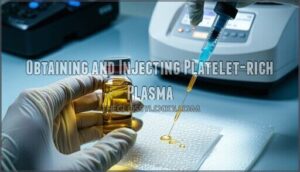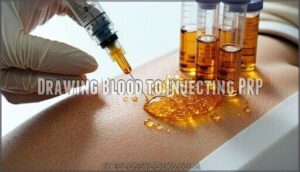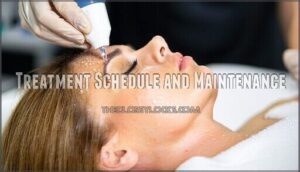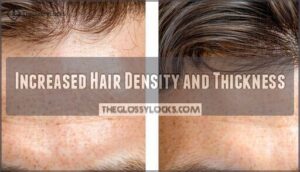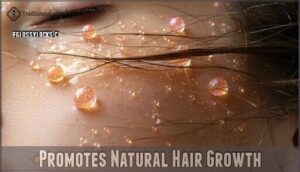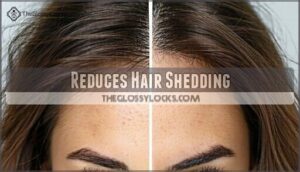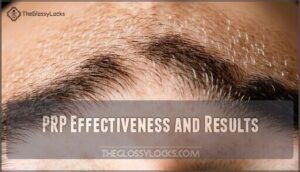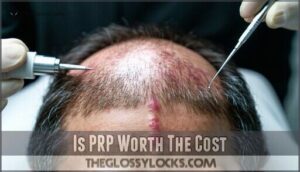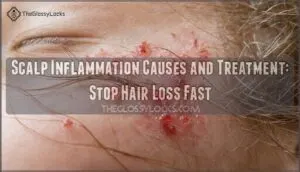This site is supported by our readers. We may earn a commission, at no cost to you, if you purchase through links.
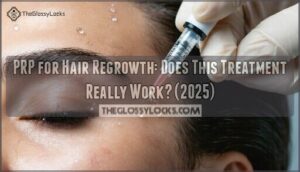 Platelet rich plasma (PRP) for hair regrowth uses your own blood’s healing powers to combat hair loss.
Platelet rich plasma (PRP) for hair regrowth uses your own blood’s healing powers to combat hair loss.
During treatment, doctors draw your blood, concentrate the platelets using a centrifuge, then inject this growth factor-rich plasma directly into your scalp.
The concentrated platelets release proteins that can wake up dormant hair follicles and strengthen existing ones.
Research shows promising results, with many patients experiencing increased hair density and reduced shedding after three to six monthly sessions.
While PRP isn’t a miracle cure, it’s proven more effective than doing nothing—and since it uses your own blood, side effects are minimal.
The science behind why some people respond better than others reveals fascinating insights about hair follicle biology, and this treatment has been found to have minimal side effects.
Table Of Contents
- Key Takeaways
- What is PRP Therapy
- PRP Procedure Steps
- Benefits of PRP Hair Loss
- PRP Effectiveness and Results
- Is PRP Worth The Cost
- Frequently Asked Questions (FAQs)
- Does PRP actually regrow hair?
- What is the average cost of PRP for hair loss?
- How much does a PRP session cost?
- How successful is PRP for hair growth?
- Does PRP regrow hair permanently?
- How long does PRP hair growth last?
- Is PRP worth the money?
- Who is not a good candidate for PRP?
- How often do you need PRP treatments?
- Are there any food or drink restrictions after PRP?
- Conclusion
Key Takeaways
- You’ll see modest but measurable results – PRP typically increases hair density by 25-46 hairs per square centimeter within 3-6 months, though it will not completely restore lost hair or work as a miracle cure.
- You’ll need ongoing treatments and a significant investment – Initial treatment requires 3-4 monthly sessions costing $500-$1,500 each, followed by maintenance treatments every 3-6 months to sustain results.
- You’re using your body’s natural healing mechanisms – PRP concentrates growth factors from your own blood to stimulate dormant hair follicles and reduce shedding, making it safer than synthetic treatments with minimal side effects.
- You’ll get better results with realistic expectations – While PRP works better than doing nothing and shows promise in clinical studies, it is most effective for early hair thinning rather than advanced hair loss, and results vary significantly between individuals.
What is PRP Therapy
PRP therapy uses your own blood to create a concentrated solution of platelets that can stimulate hair follicles and promote regrowth.
This treatment involves drawing blood from your arm, processing it to extract platelet-rich plasma, then injecting it directly into areas of your scalp experiencing hair loss.
Definition and Classification of PRP
Platelet-rich plasma represents your body’s concentrated healing power, containing 3-5 times more platelets than normal blood.
The DEPA classification system standardizes PRP types based on platelet concentration, activation methods, and purity levels.
Commercial kits use centrifuge technology to separate growth factors, with calcium chloride or thrombin activating these powerful cellular messengers for ideal therapeutic results, utilizing the body’s own healing power.
How PRP Works for Hair Growth
When you receive PRP hair regrowth treatment, growth factors within your platelet rich plasma trigger cell proliferation in dormant hair follicles.
These proteins stimulate dermal papilla cells, promoting angiogenesis around follicles and extending the anagen phase.
This hair follicle stimulation creates ideal conditions for sustainable hair regrowth results through enhanced blood supply and cellular regeneration.
Daily massage can further boost blood flow effectively to support the hair regrowth process.
Platelets and Hair Growth Connection
Your body’s platelets aren’t just clotting agents—they’re microscopic factories packed with growth factors that kickstart hair follicle revival.
When concentrated in platelet rich plasma, these growth factors target dermal papilla cells, triggering cell proliferation and angiogenesis induction.
Your platelets become powerful cellular messengers, awakening dormant follicles through concentrated growth factor delivery.
This follicle stimulation process basically wakes up dormant hair follicles, encouraging them to restart their natural growth cycle.
PRP Procedure Steps
When you decide to try PRP therapy for hair loss, you’ll go through a straightforward three-step medical procedure that takes about an hour from start to finish.
The process involves drawing your blood, processing it in a centrifuge to concentrate the platelets, and injecting the resulting plasma directly into areas of your scalp where hair thinning occurs.
Obtaining and Injecting Platelet-rich Plasma
Your healthcare provider starts by drawing 30-60 milliliters of blood from your arm using standard blood draw technique.
The sample undergoes centrifugation protocols to separate plasma layers, concentrating platelets through precise spinning cycles.
Platelet activation occurs when calcium compounds trigger growth factor release, supporting cell regeneration through platelet rich plasma delivery.
Scalp injections follow sterile procedures, with careful attention to injection depth across thinning areas for ideal delivery.
Drawing Blood to Injecting PRP
The blood draw volume typically ranges from 30 to 60 milliliters, extracted from your arm vein.
Centrifuge speed separates blood components through precise spinning.
Platelet extraction follows, concentrating growth factors.
Your practitioner uses sterile injection technique for scalp injections.
For those looking to perform the procedure themselves, understanding PRP blood draw products is essential.
Activation timing matters—PRP therapy works best within 10 minutes of blood processing to maximize platelet rich plasma effectiveness.
Treatment Schedule and Maintenance
Once your PRP injections are complete, you’ll follow a structured treatment schedule for ideal results.
Most patients need three to four initial sessions spaced four to six weeks apart, followed by maintenance treatments every six to twelve months.
Here’s your typical PRP treatment timeline:
- Initial phase: Monthly injections for first three months to establish hair regrowth therapy
- Assessment period: Wait 3-6 months to evaluate hair density improvements and scalp health maintenance
- Maintenance duration: Schedule follow-up treatments every 6-9 months for long-term planning
- Combination therapies: Consider pairing with minoxidil or finasteride for enhanced effectiveness
- Expected downtime: Resume normal activities within 24-48 hours after each session
Your treatment frequency depends on individual response and hair regrowth maintenance needs.
You can find products related to PRP treatment options online.
Benefits of PRP Hair Loss
When you’re considering PRP therapy for hair loss, you’ll want to understand the specific advantages this treatment offers beyond just stopping hair loss.
The benefits extend from measurable improvements in hair density to natural regeneration processes that work with your body’s own healing mechanisms, utilizing natural regeneration to achieve the desired outcomes.
Increased Hair Density and Thickness
Research shows you can expect measurable hair density improvement within three to six months of starting PRP treatments.
Expect measurable hair density gains within three to six months of treatment.
Studies report increases of 25-46 hairs per square centimeter, with some patients seeing 33.6 new hairs in targeted areas.
Your hair diameter also increases, creating better scalp coverage, with maintenance sessions every 3-6 months helping sustain hair regrowth results through continued follicle stimulation, leading to improved hair regrowth outcomes.
Promotes Natural Hair Growth
Unlike traditional hair loss treatments that simply mask the problem, platelet rich plasma works by awakening your body’s natural hair growth mechanisms.
This hair loss treatment harnesses growth factors from your own blood to stimulate cellular regeneration and enhance follicle stimulation through improved blood circulation and nutrient delivery.
- Follicle Stimulation: Growth factors activate dormant hair follicles, encouraging them to enter active growth phases
- Cellular Regeneration: Platelets promote healing and renewal of scalp tissue at the cellular level
- Blood Circulation: Enhanced circulation delivers essential nutrients directly to hair roots
- Nutrient Delivery: Improved scalp health creates ideal conditions for sustained hair regrowth
- Natural Hair Growth: Your body’s own healing mechanisms drive the regrowth process without synthetic chemicals
Reduces Hair Shedding
While excessive hair shedding can devastate your confidence, platelet rich plasma therapy targets key shedding mechanisms that disrupt follicle health.
PRP extends the anagen phase and stabilizes hair cycles, effectively reducing premature shedding triggers like telogen effluvium.
This hair loss prevention approach strengthens weakened follicles, promoting sustained hair regrowth while minimizing daily hair shedding.
A balanced diet can further help, as poor nutrition weakens follicles, to support hair regrowth and overall follicle health.
PRP Effectiveness and Results
You’ve probably wondered whether PRP therapy actually delivers the dramatic hair regrowth results you’ve seen advertised online.
The scientific evidence reveals a more nuanced picture, with multiple studies showing measurable improvements in hair density and thickness, though results vary substantially between individuals.
Research and Evidence for PRP
Multiple systematic reviews demonstrate that platelet rich plasma effectively promotes hair regrowth through rigorous clinical studies.
However, protocol variations across research centers create challenges in establishing standardized treatment guidelines for ideal long-term efficacy.
Key research findings that shape treatment decisions:
- Clinical trials consistently show 25-46 additional hairs per cm² compared to placebo effects
- Hair regrowth studies reveal combination therapies with minoxidil outperform standalone treatments
- Hair loss research indicates maintenance sessions every 3-6 months sustain results long-term
Studies on PRP for Hair Loss
Several clinical studies demonstrate PRP therapy’s effectiveness for hair loss treatment. You’ll find study sample sizes typically range from 20-100 participants, limiting broad conclusions.
Protocol standardization remains challenging since researchers use different preparation methods and injection techniques. Long-term efficacy shows promise, though most studies track patients for only 6-12 months.
Combination therapies with minoxidil show enhanced results compared to PRP alone. Varied patient response occurs due to individual factors like age, hair loss severity, and platelet rich plasma quality.
| Study Year | Sample Size | Hair Density Increase |
|---|---|---|
| 2019 Meta-analysis | 262 patients | 25-46 hairs/cm² |
| 2020 Review | 13 studies | Significant thickness gain |
| Controlled Trial | 23 participants | 45.9 hairs/cm² improvement |
| 2022 Analysis | Multiple cohorts | 84% showed improvement |
| Recent RCT | 40 subjects | 33.6 hair increase in target area |
Most research focuses on androgenetic alopecia, showing consistent hair regrowth patterns. However, researchers acknowledge that current evidence, while promising, requires larger randomized trials to establish definitive treatment protocols for ideal PRP therapy outcomes.
Focus on Platelet Concentration
Beyond basic platelet-rich plasma preparation, ideal concentration becomes the game-changer for hair regrowth success.
Commercial kits and centrifugation methods directly impact your treatment’s effectiveness through precise platelet count targeting. PRP therapy is effective because it acts on essential hair follicle components.
Key concentration factors affecting your PRP results:
- Ideal Concentration – Target 4-7 times baseline platelet count for maximum growth factor release
- Centrifugation Methods – Double-spin protocols achieve higher platelet concentrations than single-spin techniques
- Commercial Kits – FDA-approved systems provide consistent platelet extraction and standardized outcomes
- DEPA Classification – Standardizes treatments based on dose, efficiency, purity, and activation for predictable results
- Activation Methods – Calcium chloride or thrombin triggers immediate growth factor release within 10 minutes
Is PRP Worth The Cost
You’re likely wondering if PRP therapy justifies its price tag when compared to proven hair loss treatments like minoxidil or finasteride.
The answer depends on your specific situation, budget, and treatment goals since PRP requires ongoing sessions that can cost thousands annually.
Weighing The Costs and Benefits
Before investing in PRP therapy, you’ll want to examine the cost-benefit ratio carefully.
PRP injection costs typically range from $500-$1,500 per session, with maintenance treatments required every 3-6 months. Despite high upfront costs, patient satisfaction rates remain strong due to natural hair growth results.
To maintain healthy hair, consider that lifestyle choices matter for overall skin health.
| Cost Factor | Investment Range | Long-Term Value |
|---|---|---|
| Initial Treatment | $1,500-4,500 (3 sessions) | Natural hair regrowth |
| Annual Maintenance | $1,000-3,000 | Sustained results |
| Side Effects Risk | Minimal complications | High safety profile |
Comparing PRP to Other Hair Loss Treatments
When weighing hair loss treatment options, you’ll find that PRP offers distinct advantages over traditional methods.
Minoxidil vs. PRP studies show platelet rich plasma produces thicker, longer-lasting results with higher patient satisfaction.
Unlike Finasteride Comparison data revealing hormonal side effects, PRP uses your own blood, eliminating allergic reactions.
While Hair Transplants provide permanent solutions for advanced hair loss, this nonsurgical hair loss treatment works best for early thinning.
Alternative Therapies like Laser Therapy show promise, but hair restoration through platelet rich plasma demonstrates superior efficacy in clinical trials for hair transplant candidates seeking less invasive options.
PRP therapy leverages the body’s own resources, using growth factors and proteins to rejuvenate hair follicles.
Long-term Effects and Maintenance
PRP therapy requires ongoing commitment for sustained regrowth. Most patients see initial improvements within three months, but maintenance treatments become necessary to preserve results. Without regular sessions, hair loss typically resumes.
Your maintenance schedule should include:
- Initial phase: Three monthly treatments for foundation
- Maintenance phase: Sessions every 3-6 months thereafter
- Assessment intervals: Regular scalp evaluations to adjust timing
- Long-term planning: Annual treatments minimum for sustained results
Current research shows PRP’s long-term efficacy depends heavily on consistent repeat treatments. Future research continues investigating ideal maintenance schedules and combination therapies. While PRP therapy offers promising hair restoration results, it’s not a one-time solution – think of it as an ongoing investment in your hair’s health rather than a permanent fix.
Frequently Asked Questions (FAQs)
Does PRP actually regrow hair?
Like a gardener coaxing dormant seeds to sprout, you’re basically asking your follicles to wake up.
Research shows PRP can increase hair density by 25-46 hairs per square centimeter, but it won’t regrow hair completely.
What is the average cost of PRP for hair loss?
You’ll find treatment sessions typically cost $400 to $1,500 each, with most people needing three to six sessions initially, then maintenance treatments every few months for sustained results.
How much does a PRP session cost?
Sessions start strong, spanning $750 on average, but can range from $150 to $350 in Turkey or reach up to $3,950 depending on your location and provider’s expertise.
How successful is PRP for hair growth?
Research shows you’ll likely see positive results, with studies reporting 25-46 more hairs per square centimeter after treatment.
Most people experience increased hair density and thickness within 3-6 months of starting sessions, which can lead to positive results.
Does PRP regrow hair permanently?
While many hope for permanent hair restoration, PRP doesn’t regrow hair permanently.
You’ll need maintenance treatments every 3-6 months to sustain results, as the underlying causes of hair loss continue progressing without ongoing intervention.
How long does PRP hair growth last?
PRP hair growth typically lasts 12-18 months, but you’ll need maintenance treatments every 3-6 months to sustain results.
It’s not permanent—your hair will gradually return to its previous state without ongoing sessions.
Is PRP worth the money?
Cost-effectiveness depends on your hair loss severity and budget.
You’ll need multiple sessions ($500-2000 each) with maintenance treatments every 3-6 months.
Results vary substantially, making it a considerable investment without guaranteed outcomes.
Who is not a good candidate for PRP?
You’re not suitable if you have bleeding disorders, active infections, blood cancers, autoimmune conditions, or take blood thinners. Pregnant women should also avoid treatment until after delivery.
How often do you need PRP treatments?
Here’s the reality you’ll face: consistency matters more than frequency.
You’ll need monthly treatments for the first three months, then maintenance sessions every six to twelve months to sustain your results.
Are there any food or drink restrictions after PRP?
After your treatment, you’ll generally have no specific food or drink restrictions.
However, staying hydrated and maintaining a balanced diet supports healing.
Avoid excessive alcohol for 24-48 hours, as it can interfere with your body’s natural recovery process.
Conclusion
Unfortunately, your hair follicles aren’t subscribing to miracle cures—but platelet rich plasma PRP for hair regrowth offers genuine hope backed by science.
You’ll likely see modest improvements in hair density and reduced shedding after three to six sessions.
While it won’t transform you into Rapunzel overnight, PRP represents a safe, evidence-based option that works better than wishful thinking.
Consider your budget, expectations, and commitment to maintenance treatments before deciding.
- https://pmc.ncbi.nlm.nih.gov/articles/PMC6374694/
- https://journals.lww.com/annals-of-medicine-and-surgery/fulltext/2023/06000/novel_vs__modified_platelet_rich_plasma_therapy.85.aspx
- https://newsnetwork.mayoclinic.org/discussion/science-saturday-platelet-rich-plasma-found-to-be-effective-in-regrowing-hair/
- https://esteem.pennstatehealth.org/service/platelet-rich-plasma-injections-for-patterned-hair-loss/
- https://www.centerforadvancedurology.com/patient-education/the-benefits-of-prp-for-hair-restoration-a-comprehensive-guide/

